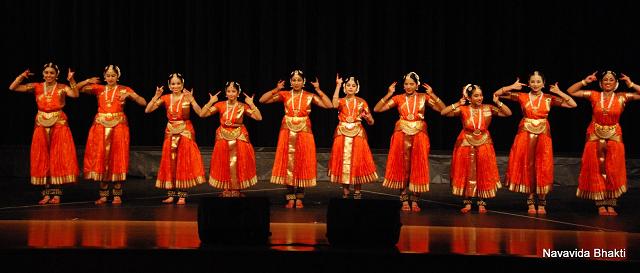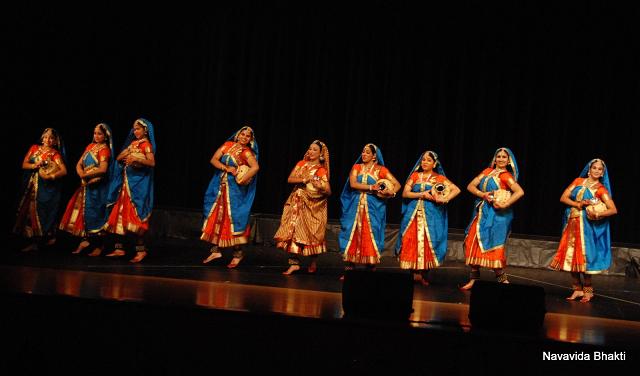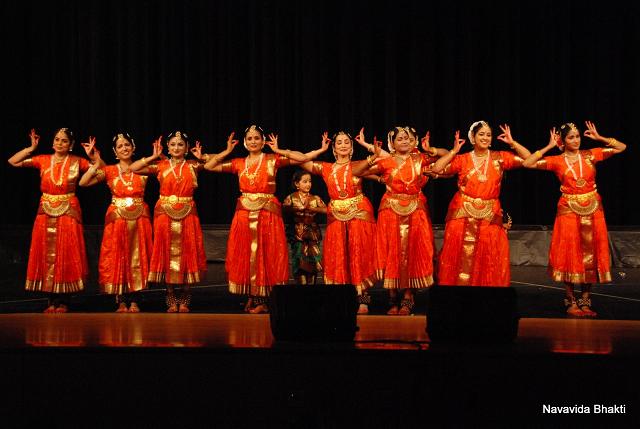Contribute
| Navavidha Bhakti - A Scintilating Syncronicity Of Devotion And Dance |
Dr. R.Subrahmonia Ayyar
07/21/2011
Navavidha Bhakti - Nine Pathways to Devotion, a dance ballet presented by over thirty three local dancers was a rare high quality classical dance presentation where devotion and art merged to elevate the soul of the artist and the audience. Held at the Ashland High School auditorium in Ashland, MA on Saturday July 17, 2011, the event was hosted by VisionAid, to raise funds for the underpriviledged visually challenged people in India.
The evening opened with a brief presentation on VisionAID by founder Ramakrishna Raju and President Anu Chitrapu. Special invitee, Puran Dang and chief guest Subu Kota spoke about their support for the cause.
The dance segment opened befittingly with a presentation from Sunada Dance Group featuring blind dancers. Their rendition of Annamacharya’s Sriman Narayana was brilliant and their visual challenge seemed no impediment to the fine performance. The group is part of Samarthanam, an organization that seeks to empower blind people. The team leader Mahentesh , thanked Vision AID for the opportunity.
The program then shifted to the main attraction of the evening – Navavidha Bhakti where nine stories from the Hindu scriptures were used as exemplars to describe the nine forms of devotion. The choreographer, Kalamandalam Lata intertwined Nritta and Abhinaya brilliantly to create a dazzling visual spectacle that conveyed philosophical ideas.
“Sravanamâ€, or listening was depicted through “Prahalada Charitaramâ€. Kayathu the wife of the Raksha king Hiranyakashpu , sworn enemy of Lord Naryana was captured by the Devas while she was pregnant and lived in hiding in the Ashrama of Narada. The little baby in the womb constantly listened (“Sravanamâ€) to the name of the Lord while in the womb and this instills devotion in the child. He transforms into an ardent devotee of the Lord much to the horror of his father Hiranyakshapu who tries to kill his own son by throwing him into water and fire. The Lord protects Prahalada and in the end appears in the form of Narasimha (half man half lion form) and kills Hiranyakashpu. Ranjani Saigal as the evil Hiranyakashpu, Suja Meyyapan as Narasimha and little Madhumita Nambiar as Prahalada gave a most memorable performance. Tanuja Meenakshinathan played the role of Mahavishnu.
Ranjani Saigal changed character from Hiranyakashpu, the enemy of the Lord to don the role of Narayana Bhattathiri, an ardent devotee of the Lord who was cured from “Vatha Roga†by the singing of the Lord’s name - Keertanam. Bhattathiri composed the magnum opus Narayaneeyam where he described the ten avataras or incarnations of Mahavishnu. Ranjani's Abhinaya showing the suffering of Bhattadhari was very touching and brought a tear to some in the audience.
Sailja Tummala and Vyju Gopalan were the main characters in the next episode – Gajendra Mokasham where the Elephant king is saved from the clutches of a crocodile by Mahavishnu who appears just as Gajendra thinks of Him (Smaranam). Sailaja and Vyju’s Angik Abhinaya was commendable in that they were precise in depicting the movements of the elephant and crocodile. The arrival of Mahavishnu (Priya Girish) on Garuda was beautifully choreographed. The bird sound in the music track added tremendously to the impact of the piece.
The fourth episode – Padasevanam – worshiping the feet of the Lord was exemplified through the character of Akrura. The devout Akrura baths himself in the sand taken from the footprint of Krishna and Balarama. For his devotion , he was rewarded with a Darshan of Mahavishnu. Kalapana Balachandar brought out the spirit of Akrura beautifully. Amrita Saigal played the role of the adult Lord Krishna. Mansi Danke and Neha Pillai played the role of the young Krishna and Balarama.
The fifth episode – Sri Krishna Tulabaram showed the power of Archana or offering of flower to the Lord. Krishna’s egotistical consort Sathyabama is so proud of her wealth that she wants to have a Tulabaram for her husband – (donation of gold equivalent to the weight of her husband). Unfortunately all her gold does not equal the weight of the Lord. Rukmini, the devout consort offers just a leaf for the Tulabaram and tips the balance. Sheetal Dwarika played the role of the beautiful and egotistical Sathyabama to perfection. Jeyanthi Ghatraju played the role of Rukmini, while Sapna Krishnan was Krishna.
Vandanam or prayer was depicted using the Akshyapatra episode where Draupadi’s prayer to Krishna saved the Pandavas from damnation. Sheetal Dwarika played the role of Draupadi, Shubha Kannath, Krishna and Vyju Gopalan was Durvasa. Amrita Saigal, Thanuja Meenakshinathan, Dhanashree Karmakar, Kalpana Balachandar and Priya Girish played the role of the Pandavas.
Jeyanthi Ghatraju gracefully depicted the pious Manjula, a Dasa (servant) at the Guruvayoor temple. Garland made by Manjula miraculously appears on the neck of the Lord. Dhanashree played the role of Poonthanam, the great spiritual master from Kerala. Kudos to Smt. Lata for transforming a simple story into a brilliant choreography.
Sakhyam (friendship) came next as Sapna Krishnan presented the story of Kuchela (Sudama). Her Abhinaya as the poor Sudhama, nervous about meeting Krishna was wonderful. Priya Girish played the role of Kuchela’s wife, Suja Meyappan was Krishna. Amrita Saigal and Shubha Kannath played the roles of Rukmini and Sathyabama.
The last scene Atmanivedanam was a scintillating display of the dance of Radha and Krishna concluding with Radha's complete surrender to the Lord.
The piece reflected the ecstatic dance of Gopis and Krishna as they seek spiritual union. Nivedha Bhaskaran played the role of Radha and Meenu Rajendraprasad of Krishna.
Rarely has one witnessed such a beautiful presentation where each participant gave their absolute best and every movement was perfectly in place. The uniform costume with variations created with the use of shawls was brilliant . The excellent English narration made the presentation accessible to the lay audience. The music for the piece enhanced the entire presentation tremendously. Ramachandran's voice was able to correctly bring out the appropriate bhavams. The ragams and the lyrics were perfectly chosen. The standing ovation from the houseful audience and the accolades received was a testament to the beauty of the presentation.
This presentation from Vision AID was the fourth following on the footsteps of Ramayana, Krishna and Silapadhikaram. While the audience was thoroughly entertained, the fundraising that occurred during the event gave great meaning to the presentation as it enables Vision AID to continue its great work.
Cast and Crew
Producers: Jeyanthi Ghatraju, Sapna Krishnan , Ranjani Saigal
Concept, Lyrics and Choregraphy: Kalamandalam Lata
Advisor/Costume Designer: Mr Thamban Kambrath
Narration: Priya and Vijay Moorthy
Music direction and flute - Jayaprakash Kannur
Vocal - Sangeetharathnam C Ramachandran
Lyrics - Mrs Latha Edavalath and Mrs Vidhyalakshmi
Morsing - Kannur PK Santosh
Veena - Trissur Murali Krishna
Mridangam - Mukkam Saleem
Keyborad - Nitha Prakash
Rhythm composer - Santosh Kannur
Dancers:
Aishwarya Nambi, Amrita Saigal, Chaitanya Gopu, Devi Patel, Suja Meyappan, Richa Singh, Dhanashree Karamakar, Jeyanthi Gharaju, Kalpana Balachandar, Susruthi Rajanala, Karishma Reddy, Madhumita Nambiar, Manasi Danke, Maithreyi Shankar, Meenu Rajendraprasad, Neha Pillai, Nisha Pillai, Nikita Minocha, Nilanjana Nambiar, Nivedha Baskaran, Nivedha Kumar, Prerana Patil, Priya Girish, Ranjani Saigal, Thanuja Meenakshinathan, Sailaja Chaudhary Tummala, Sandhya Reddy, Sapna Krishnan, Sheetal Dwaraka, Shubha Kannath, Susmitha Saripalli, Vyju Prasad and Roshni Narasimhan.
You may also access this article through our web-site http://www.lokvani.com/
Photos: Saravanan Meyappan


